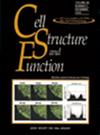MGSE Regulates Crosstalk from the Mucin Pathway to the TFE3 Pathway of the Golgi Stress Response.
IF 2.2
4区 生物学
Q4 CELL BIOLOGY
引用次数: 0
Abstract
The Golgi apparatus is an organelle where membrane or secretory proteins receive post-translational modifications such as glycosylation and sulfation, after which the proteins are selectively transported to their final destinations through vesicular transport. When the synthesis of secretory or membrane proteins is increased and overwhelms the capacity of the Golgi (Golgi stress), eukaryotic cells activate a homeostatic mechanism called the Golgi stress response to augment the capacity of the Golgi. Four response pathways of the Golgi stress response have been identified, namely the TFE3, CREB3, HSP47, and proteoglycan pathways, which regulate the general function of the Golgi, apoptosis, cell survival, and proteoglycan glycosylation, respectively. Here, we identified a novel response pathway that augments the expression of glycosylation enzymes for mucins in response to insufficiency in mucin-type glycosylation in the Golgi (mucin-type Golgi stress), and we found that expression of glycosylation enzymes for mucins such as GALNT5, GALNT8, and GALNT18 was increased upon mucin-type-Golgi stress. We named this pathway the mucin pathway. Unexpectedly, mucin-type Golgi stress induced the expression and activation of TFE3, a key transcription factor regulating the TFE3 pathway, suggesting that the activated mucin pathway sends a crosstalk signal to the TFE3 pathway. We identified an enhancer element regulating transcriptional induction of TFE3 upon mucin-type Golgi stress, and named it the mucin-type Golgi stress response element, of which consensus was ACTTCC(N9)TCCCCA. These results suggested that crosstalk from the mucin pathway to the TFE3 pathway has an important role in the regulation of the mammalian Golgi stress response.Key words: Golgi stress, mucin, TFE3, organelle autoregulation, organelle zone.MGSE调控高尔基应激反应中从粘蛋白途径到TFE3途径的串扰。
高尔基体是一种细胞器,膜或分泌蛋白在其中接受翻译后修饰,如糖基化和硫酸化,之后蛋白质通过囊泡运输选择性地转运到最终目的地。当分泌蛋白或膜蛋白的合成增加并超过高尔基体的能力(高尔基应激)时,真核细胞激活一种称为高尔基应激反应的稳态机制来增强高尔基体的能力。目前鉴定出高尔基体应激反应的4条应答通路,分别是TFE3、CREB3、HSP47和蛋白多糖通路,它们分别调控高尔基体的一般功能、细胞凋亡、细胞存活和蛋白多糖糖基化。在这里,我们发现了一种新的反应途径,在高尔基体中,当粘蛋白型糖基化不足时,增加粘蛋白糖基化酶的表达(粘蛋白型高尔基应激),我们发现粘蛋白糖基化酶如GALNT5、GALNT8和GALNT18的表达在粘蛋白型高尔基应激下增加。我们将这一途径命名为粘蛋白途径。出乎意料的是,粘蛋白型高尔基应激诱导了调控TFE3通路的关键转录因子TFE3的表达和激活,表明被激活的粘蛋白通路向TFE3通路发送了串扰信号。我们鉴定出一个调节TFE3在黏素型高尔基胁迫下转录诱导的增强元件,并将其命名为黏素型高尔基胁迫应答元件,一致命名为actcc (N9)TCCCCA。这些结果表明,从粘蛋白途径到TFE3途径的串扰在哺乳动物高尔基应激反应的调控中具有重要作用。关键词:高尔基应激,粘蛋白,TFE3,细胞器自调节,细胞器区
本文章由计算机程序翻译,如有差异,请以英文原文为准。
求助全文
约1分钟内获得全文
求助全文
来源期刊

Cell structure and function
生物-细胞生物学
CiteScore
2.50
自引率
0.00%
发文量
6
审稿时长
>12 weeks
期刊介绍:
Cell Structure and Function is a fully peer-reviewed, fully Open Access journal. As the official English-language journal of the Japan Society for Cell Biology, it is published continuously online and biannually in print.
Cell Structure and Function publishes important, original contributions in all areas of molecular and cell biology. The journal welcomes the submission of manuscripts on research areas such as the cell nucleus, chromosomes, and gene expression; the cytoskeleton and cell motility; cell adhesion and the extracellular matrix; cell growth, differentiation and death; signal transduction; the protein life cycle; membrane traffic; and organelles.
 求助内容:
求助内容: 应助结果提醒方式:
应助结果提醒方式:


